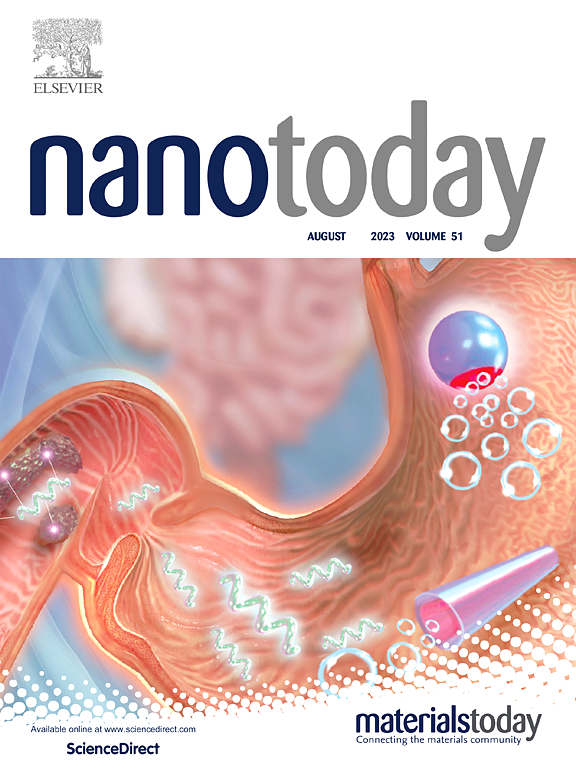在缺陷工程纳米平台上通过超小Ir支持的金属团簇催化免疫治疗肿瘤代谢破坏和增强免疫原性细胞死亡
IF 10.9
1区 材料科学
Q1 CHEMISTRY, MULTIDISCIPLINARY
引用次数: 0
摘要
免疫原性细胞死亡(ICD)是一种很有前景的免疫治疗途径,但其疗效受到适度诱导ICD和恶性肿瘤微环境(TME)的阻碍。我们设计了一种多功能纳米催化剂(G@Ir/MnFe-MMO),具有定制的MnFe-MMO纳米片,其中含有丰富的氧空位(Ov),可作为超小ir支持金属团簇(Ir-SMCs)的锚定位点,并形成Mn-Ov-Fe电子桥,以促进定向电子转移。这种独特的结构安排通过加速Ir-SMCs位点的ROS生成和实现有效的NADH(还原性烟酰胺腺嘌呤二核苷酸)氧化来增强催化活性,从而诱导氧化还原不平衡和破坏肿瘤代谢稳态。在808 nm激光照射下,氧化应激和NADH的快速消耗破坏氧化还原平衡,使线粒体膜去极化并排出三磷酸腺苷(ATP),引发持续的内质网(ER)应激,放大损伤相关分子模式(DAMPs)的释放并加强ICD。此外,负载乳酸脱氢酶A (LDHA)抑制剂GNE-140抑制乳酸生成并阻断NAD+(氧化烟酰胺腺嘌呤二核苷酸)再生,最终缓解TME驱动的免疫抑制,增强TME内炎症免疫细胞的持久性和活性。因此,G@Ir/MnFe-MMO不仅可以诱导有效的ICD,还可以增强肿瘤免疫浸润和全身抗肿瘤反应,从而在体内显著抑制原发和远处肿瘤。该策略为克服肿瘤代谢可塑性和提高基于icd的肿瘤免疫治疗的临床疗效提供了一个令人信服的治疗范式。本文章由计算机程序翻译,如有差异,请以英文原文为准。
Catalytic immunotherapy via ultrasmall Ir supported metal clusters on defect-engineered nanoplatforms for tumor metabolic disruption and enhanced immunogenic cell death
Immunogenic cell death (ICD) is a promising immunotherapy route, yet its efficacy is hampered by modest ICD induction and the hostile tumor microenvironment (TME). We engineer a multifunctional nanocatalyst (G@Ir/MnFe-MMO), with tailored MnFe-MMO nanosheets containing abundant oxygen vacancies (Ov) that serve as anchoring sites for ultrasmall Ir-supported metal clusters (Ir-SMCs) and form Mn–Ov–Fe electron bridges to facilitate directional electron transfer. This unique structural arrangement enhances catalytic activity by accelerating ROS generation at Ir-SMCs sites and enabling efficient NADH (reduced nicotinamide adenine dinucleotide) oxidation, thereby inducing redox disequilibrium and collapsing tumor metabolic homeostasis. Upon 808 nm laser irradiation, oxidative stress and the rapid NADH depletion collapses redox balance, depolarizes the mitochondrial membrane and drains adenosine triphosphate (ATP), provoking sustained endoplasmic reticulum (ER) stress that magnifies damage-associated molecular patterns (DAMPs) release and strengthens ICD. Furthermore, the loaded lactate dehydrogenase A (LDHA) inhibitor GNE-140 quenches lactate production and blocks NAD+ (oxidized nicotinamide adenine dinucleotide) regeneration, ultimately relieving TME-driven immunosuppression and enhancing the persistence and activity of inflammatory immune cells within TME. Consequently, G@Ir/MnFe-MMO not only induces potent ICD but also enhances tumor immune infiltration and systemic antitumor responses, leading to significant suppression of both primary and distant tumors in vivo. This strategy provides a compelling therapeutic paradigm for overcoming tumor metabolic plasticity and boosting the clinical efficacy of ICD-based tumor immunotherapy.
求助全文
通过发布文献求助,成功后即可免费获取论文全文。
去求助
来源期刊

Nano Today
工程技术-材料科学:综合
CiteScore
21.50
自引率
3.40%
发文量
305
审稿时长
40 days
期刊介绍:
Nano Today is a journal dedicated to publishing influential and innovative work in the field of nanoscience and technology. It covers a wide range of subject areas including biomaterials, materials chemistry, materials science, chemistry, bioengineering, biochemistry, genetics and molecular biology, engineering, and nanotechnology. The journal considers articles that inform readers about the latest research, breakthroughs, and topical issues in these fields. It provides comprehensive coverage through a mixture of peer-reviewed articles, research news, and information on key developments. Nano Today is abstracted and indexed in Science Citation Index, Ei Compendex, Embase, Scopus, and INSPEC.
 求助内容:
求助内容: 应助结果提醒方式:
应助结果提醒方式:


